Wetland Assessment and Monitoring
We have a rich history of assessing wetland condition using traditional Heritage protocols, but it wasn’t until our involvement is US EPA’s first National Wetland Condition Assessment in 2011 that we began wading into quantitative wetland assessment protocols – a first for New York State. Four years later NYNHP hired its first Wetland Ecologist, Laura Shappell, PhD, who works with her colleagues to grow our understanding of wetland natural resources across New York State (NYS).
Over the past ten years we have surveyed over 250 wetlands, developed quantitative methods for assessing wetland condition, tested the importance of intact natural buffers around wetlands (they are important!), explored vernal pool productivity, generated preliminary floristic quality benchmarks, and are currently developing protocols for assessing wetland functions and values. We’ve been busy, but none of this would have been possible without our agency partners and dozens of private land owners that have allowed us to survey on their property. Thank you!
All of this groundbreaking work is conducted in collaboration with our partners at NYS Department of Environmental Conservation (NYS DEC) and agency partners such at the Adirondack Park Agency (APA) and New York City Department of Environmental Protection (NYC DEP). These collaborations ensure our projects are relevant to their organization’s regulatory programs, management practices, and stewardship goals. Our work allows us to answer applied management questions with science-based research focused on understanding and conserving NYS’ crucial wetland resources.
Meet Our Wetland Program Field Team!
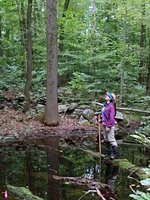
Laura Shappell, Ph.D., Wetland Ecologist, Team Leader
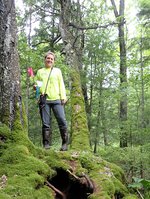
Lydia Sweeney, Seasonal Assistant Ecologist
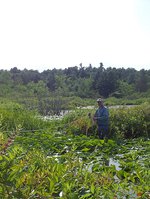
Greg Edinger, Chief Ecologist
Landowner Permission
Receive a letter from us requesting permission to survey a wetland on your personal property or your organization's property? Please complete our online landowner response form.
Wetland Projects
Wetland Functional Assessment and Pollinator Biodiversity
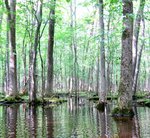
Project Webpage
Project Title
Developing methods, cultivating engagement, and creating end-user tools for wetland functional assessment
Partners
NYS DEC
Research Topics/Keywords
ecosystem functions, ecosystem values, rapid assessment, wetland condition assessment, three-tiered assessment, wetland floristic quality, wetland functional assessment
Project Title
Improving Onsite and Remote Wetland Functional Assessment: A Focus on New York City Water Supply Basins.
Partners
NYS DEC, NYC DEP
Research Topics/Keywords
ecosystem functions, ecosystem values, rapid assessment, wetland condition assessment, three-tiered assessment, wetland floristic quality, wetland functional assessment, pollinator biodiversity, wetland pollinators
Vernal Pool Assessment and Mapping in NYS
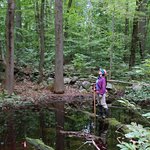
Project Webpage
Partners
NYS DEC, SUNY College of Environmental Science and Forestry, NY State Parks, and the Upper Susquehanna Coalition (USC)
Project Title
Determining the importance of vernal pools across geophysical and urbanization gradients to inform regulation, conservation, and management
Research Topics/Keywords
egg mass surveys, habitat structure, rapid assessment, vernal pool assessment, unusual local importance, wetland condition assessment, wetland floristic quality
Supporting Actionable Decision-Making For Wetland Permitting In New York From Urban To Rural Environments
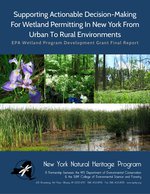
Project Webpage
Partners
NYS DEC
Final Report Citation
Laura J. Shappell and Timothy G. Howard. 2018. Supporting Actionable Decision-Making For Wetland Permitting In New York From Urban To Rural Environments. EPA Wetland Program Development Grant. Final Report. New York Natural Heritage Program, Albany, NY.
Research Topics/Keywords
adjacent land use/land cover (LULC), ecological integrity, historical land use/land cover, rapid assessment method, three-tiered assessment, upland buffer, wetland condition assessment, wetland floristic quality, wetland monitoring
Statewide Riparian Opportunity Assessment
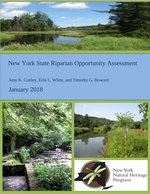
Project Webpage
Final Report Citation
Amy Conley, Erin White, and Timothy Howard. 2018. New York State Riparian Opportunity Assessment. New York Natural Heritage Program, State University of New York College of Environmental Science and Forestry, Albany, NY. Final report (PDF, 9.5 MB)
Research Topics/Keywords
fish restoration, natural resource management, restoration prioritization, riparian functions, riparian management, riparian restoration, spatial modeling, water quality, watershed management
Wetland Monitoring for Lake Ontario Adaptive Management
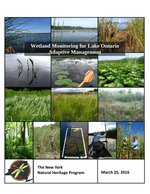
Project Webpage
Lake Ontario Adaptive Management Wetland Monitoring
Final Report Citation
Timothy G. Howard, Aissa L. Feldmann, Elizabeth A. Spencer, and Richard M. Ring, Kelly A. Perkins, and Jeff Corser. 2016. New York State Wetland Condition Assessment. EPA Wetland Program Development Grant. EPA Wetland Program Development Grant. Final Report. New York Natural Heritage Program, Albany, NY.
Research Topics/Keywords
wetland monitoring, Great Lakes wetlands, vegetation zoneation, water level fluctuations, hydrogeomorphic type (HGM), elevation benchmarks
National Wetland Condition Assessment
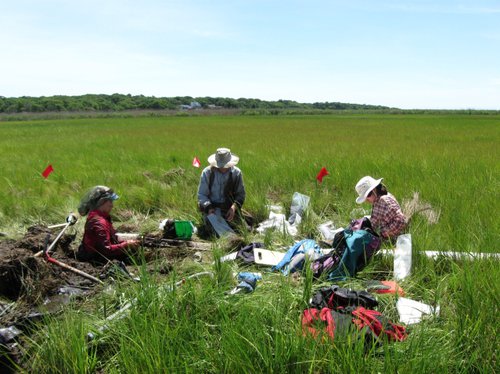
NYNHP and NRCS staff collecting soil samples in a salt marsh at Wertheim National Wildlife Refuge (Suffolk County). Photo by Laura Shappell.
Project Webpage
US EPA Webpage
Research Topics/Keywords
National Wetland Condition Assessment, wetland assessment, wetland floristic quality, wetland monitoring
New York State Wetland Condition Assessment
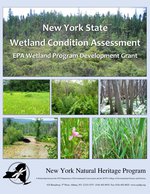
Project Webpage
NYS Wetland Condition Assessment
Final report citation
Laura J. Shappell, Aissa L. Feldmann, Elizabeth A. Spencer, and Timothy G. Howard. 2016. New York State Wetland Condition Assessment. EPA Wetland Program Development Grant. EPA Wetland Program Development Grant. Final Report. New York Natural Heritage Program, Albany, NY.
Research Topics/Keywords
wetland condition assessment, rapid assessment method, three-tiered assessment, wetland floristic quality, wetland monitoring, Landscape Condition Assessment model (LCA)
Pilot Wetland Condition Assessment of Palustrine Emergent Marsh in the Upper Hudson River Watershed
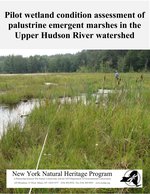
Partners
NYSDEC Division of Water
NYSDEC Division of Fish and Wildlife, Wetlands Program
Final Report Citation
Aissa L. Feldmann, and Timothy G. Howard, and Elizabeth A. Spencer. 2012. Pilot wetland condition assessment of palustrine emergent marsh in the Upper Hudson River watershed. A report prepared for the NYSDEC Division of Water by the New York Natural Heritage Program. Albany, NY.
Research Topics/Keywords
wetland assessment, rapid assessment method, wetland monitoring
Detecting Climate Change in Wetlands in Adirondack Park
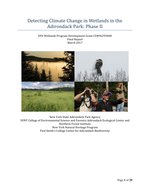
Partner
Adirondack Park Agency
Final Report Citation
Langdon, S.F., G.J. Edinger, P.B. Hai, S. McNulty, S. Beguin, D. Patrick (eds.), E. Snizek, and L. Walrath. 2017. Detecting Climate Change in Wetlands in the Adirondack Park: Phase II. A report prepared for the U.S. EPA. (PDF, 1.7 MB)
Research Topic/Keywords
long-term wetland monitoring; citizen science; Adirondacks; climate change
Select Additional Wetland-Related Projects, Publications, Community Mapping, and NYNHP Field Inventories
Howard, T., L. Shappell, and N. Smith. 2017. 2017 field surveys of Great Lakes coastal wetlands. Prepared for the Great Lakes-St. Lawrence River Adaptive Management (GLAM) Committee. New York Natural Heritage Program, Albany, NY. [GLAM-published summary report (PDF, 16 MB).]
Langdon, S.F., G.J. Edinger, P.B. Hai, S. McNulty, S. Beguin, D. Patrick (eds.), E. Snizek, and L. Walrath. 2017. Detecting Climate Change in Wetlands in the Adirondack Park: Phase II. A report prepared for the U.S. EPA. Report link:
Edinger, G.J., A.L. Feldmann, T.G. Howard, J.J. Schmid, F.C. Sechler, E. Eastman, E. Largay, L.A. Sneddon, C. Lea, and J. Von Loh. 2014. Vegetation Inventory: Saratoga National Historical Park, New York. Natural Resource Technical Report NPS/NETN/NRTR-2014/XXX, National Park Service, Fort Collins, Colorado.
Bried, J.T. and G.J. Edinger. 2009. Baseline floristic and classification of pine barrens vernal ponds. Journal of the Torrey Botanical Society 136(1): 128-136.
Sechler, F.C., G. J. Edinger, T.G. Howard, J.J. Schmid, E. Eastman, E. Largay, L.A. Sneddon, C. Lea, and J. Von Loh. 2014. Vegetation Classification and Mapping at Roosevelt-Vanderbilt National Historic Sites, New York.. Natural Resource Technical Report NPS/NETN/NRTR-2014/XXX, National Park Service, Fort Collins, Colorado. Vegetation Classification and Mapping at Gateway National Recreation Area. NPS/NER/NRTR—2008/107. Technical Report National Park Service. Northeast Region. Philadelphia, PA. [Spatial data: NPS project page]
Edinger, G.J., A.M. Chaloux, J.D. Corser, A.L. Feldmann, K.A. Perkins, R.M. Ring, M.D. Schlesinger, and E.L. White. 2013. Rare Species and Significant Natural Communities of Fort Drum Military Installation. New York Natural Heritage Program, Albany, NY.
Edinger, G.J., S.C. Brock, A.M. Chaloux, J.D. Corser, L. Lyons-Swift, M.D. Schlesinger, J.J. Schmid, F.C. Sechler, Jr., and E.L. White. 2011. Ecological and zoological inventory of the Saratoga Sandplains. New York Natural Heritage Program. Albany, NY. 128 pp.
Swift, L., J. Corser, R. Ring, J. Schmid, T. Howard, E. Spencer. 2011. Sandy Creeks Watershed Inventory and Landscape Analysis. A report prepared for the NYS Tug Hill Commission. New York Natural Heritage Program. Albany NY. 114 pages.
Ring, R., F. Sechler, J. Corser, T. Howard, G. Edinger, K. Perkins, and E. White. 2009. 2009 field surveys of Adirondack Woodlands (Finch-Pruyn) easement properties. Prepared for the Adirondack Nature Conservancy. New York Natural Heritage Program, New York State Department of Environmental Conservation, Albany, NY. 17 pp. plus appendices.
Ring, R., F. Sechler, J. Corser, G. Edinger, T. Howard, Kelly Perkins, M. Schlesinger, and E. White. 2009. 2009 field surveys of Elk Lake-Clear Pond Preserve. Prepared for the Adirondack Nature Conservancy. New York Natural Heritage Program, Albany, NY. 31 pp. plus appendices.
Sechler, F. 2009. Inventory, classification, and description of riparian natural community reference types for West Kill Watershed, New York. Prepared for the Greene County Soil and Water Conservation District and NYC DEP Stream Management Program. New York Natural Heritage Program, Albany, NY. 78 pp. plus appendices.
Edinger, G.J., A.L. Feldmann, T.G. Howard, J.J. Schmid, E. Eastman, E. Largay, and L.A. Sneddon. 2008. Vegetation Classification and Mapping at Sagamore Hill National Historic Site. Technical Report NPS/NER/NRTR--2008/XXX. National Park Service. Northeast Region, Coastal Institute in Kingston, University of Rhode Island, Kingston, RI. [Spatial data: NPS Data Store]
Howard, T.G., M. Schlesinger, J. Corser, G. Edinger, L. Lyons-Swift, K. Perkins, R. Ring, F. Sechler, E. White, and S. Young. 2008. Field Surveys of Adirondack Woodlands (Finch-Pruyn) Easement Properties. Prepared for the Adirondack Nature Conservancy. New York Natural Heritage Program, Albany, NY.
Hunt, D.M., G.J. Edinger, A.L. Feldmann, J.J. Schmid, and C.N. Voight. 2005. Tug Hill: Stream System Inventory and Watershed Integrity Analysis. NY Natural Heritage Program. Albany, NY.
Gebauer, S., P. Novak, and B. Ketcham. 2004. Raquette River wetlands: rare species & significant ecological communities.A report prepared for Adirondack Nature Conservancy & Adirondack Land Trust. New York Natural Heritage Program, New York State Department of Environmental Conservation. Albany, NY. 20 pp. plus appendices.
Gebauer, S., G. Edinger, T. Howard, J. Jaycox, and T. Weldy. 2002. Oswego County coastal wetlands. A report prepared for the Oswego County Department of Planning and Community Development. New York Natural Heritage Program, New York State Department of Environmental Conservation. Albany, NY. 79 pp. plus appendices.
Hunt, D.M., G.J. Edinger, J.J. Schmid, D.J. Evans, P.G. Novak, A.M. Olivero, and S.M. Young. 2002. Lake Erie Gorges biodiversity inventory and landscape integrity analysis. Final report prepared for the Central/Western New York Chapter of The Nature Conservancy. New York Natural Heritage Program, New York State Department of Environmental Conservation. Albany, NY. 99 pp + appendices and maps.
Klopfer S. D., A. Olivero (NYNHP), L. Sneddon, J. Lundgren. 2002. Final Report of the NPS Vegetation Mapping Project at Fire Island National Seashore (PDF, 3.3 MB). Virginia Polytechnic Institute and State University. Blacksburg, VA. [Spatial data: NPS Project Page]
MacDonald, D. and G. Edinger. 2000. Identification of reference wetlands on Long Island, New York. Final report prepared for the Environmental Protection Agency, Wetland Grant CD992436-01. New York Natural Heritage Program, New York State Department of Environmental Conservation. Latham, NY. 106 pp. plus appendices.
Edinger, G.J. 1998. Big Bay Swamp and Camp Zerbe biodiversity inventory summary report. Final report prepared for the Oswego County Environmental Management Council. New York Natural Heritage Program, New York State Department of Environmental Conservation, Latham, NY.
NYNHP. 1998. The Great Swamp watershed natural community and rare plant inventory final report. Final report prepared for The Nature Conservancy Great Swamp Program. New York Natural Heritage Program, New York State Department of Environmental Conservation, Latham, NY.
Novak, P.G., G. Edinger, and D. Albert. 1997. Ashland Flats Wildlife Management Area biodiversity inventory final report. Prepared for New York State Department of Environmental Conservation, Return a Gift to Wildlife project number W-11. New York Natural Heritage Program, New York State Department of Environmental Conservation. Latham, NY. 46 pp. plus appendices.
Novak, P.G., G. Edinger, D. Albert, and N. Davis-Ricci. 1997. Bog Brook Unique Area biodiversity inventory final report, Return a Gift to Wildlife project number W-11. Prepared for New York State Department of Environmental Conservation. New York Natural Heritage Program, New York State Department of Environmental Conservation. Latham, NY. 24 pp. plus appendices.
Novak, P.G., G. Edinger, and N. Davis-Ricci. 1996. Braddock Bay Fish and Wildlife Management Area biodiversity inventory final report, Return a Gift to Wildlife project number W-11. Prepared for New York State Department of Environmental Conservation. New York Natural Heritage Program, New York State Department of Environmental Conservation. Latham, NY. 30 pp. plus appendices.
Nov. 24, 2020 | Updated April 12, 2023, 6:29 p.m.